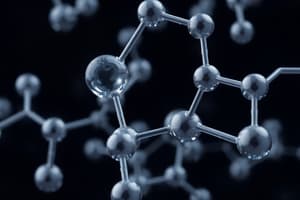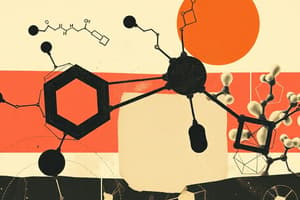Podcast
Questions and Answers
What is the primary function of carbohydrates in the body?
What is the primary function of carbohydrates in the body?
- They participate in immune responses.
- They provide structure to cell membranes.
- They serve as an essential source of energy. (correct)
- They are involved in the synthesis of hormones.
Which characteristic is true of monosaccharides?
Which characteristic is true of monosaccharides?
- They are commonly classified as di- or polysaccharides.
- They usually have a carbon atom range of three to six. (correct)
- They always exist in linear chains.
- They contain more than six carbon atoms.
How do plants produce glucose?
How do plants produce glucose?
- By the process of photosynthesis using carbon dioxide and water. (correct)
- Through cellular respiration using starch.
- Through the absorption of glucose from their surroundings.
- By breaking down polysaccharides in the soil.
What is the general formula for carbohydrates?
What is the general formula for carbohydrates?
Which of the following statements about glucose, galactose, and fructose is true?
Which of the following statements about glucose, galactose, and fructose is true?
What are biological macromolecules primarily composed of?
What are biological macromolecules primarily composed of?
Which element is described as the foundation for biological molecules?
Which element is described as the foundation for biological molecules?
How many covalent bonds can a single carbon atom form?
How many covalent bonds can a single carbon atom form?
What is the simplest organic carbon molecule?
What is the simplest organic carbon molecule?
What structural forms can carbon compounds take?
What structural forms can carbon compounds take?
In the context of biological macromolecules, which of the following elements is NOT commonly a part of their structure?
In the context of biological macromolecules, which of the following elements is NOT commonly a part of their structure?
Which biological macromolecule is commonly associated with energy storage?
Which biological macromolecule is commonly associated with energy storage?
What aspect of carbon’s bonding properties contributes to the diversity of biological macromolecules?
What aspect of carbon’s bonding properties contributes to the diversity of biological macromolecules?
Flashcards are hidden until you start studying
Study Notes
Biological Macromolecules
- Large molecules essential for life, built from smaller organic molecules.
- Four major classes: carbohydrates, lipids, proteins, and nucleic acids.
- They are the primary components of cells and perform various functions.
- Make up the majority of a cell's mass.
- Contain carbon and can contain hydrogen, oxygen, nitrogen, phosphorus, sulfur, and minor elements.
Carbon's Importance
- Carbon is the "foundation" element for molecules in living things.
- Carbon forms four covalent bonds with other atoms or molecules due to the presence of four electrons in its outer shell.
Carbon Bonding
- Methane (CH4) is the simplest organic carbon molecule with four hydrogen atoms bound to a carbon atom.
- Carbon can form long and branching chains by bonding with other carbon atoms.
- Carbon can bond with nitrogen, oxygen, and phosphorus atoms, creating a variety of molecular structures.
- Carbon can form rings that can link with other rings.
- The diversity of carbon bonding allows for the diversity of biological macromolecule functions.
Carbohydrates
- Essential part of our diet, providing energy to the body.
- Sources: grains, fruits, and vegetables.
- Formula: (CH2O)n, where n is the number of carbon atoms.
- Ratio of carbon to hydrogen to oxygen is 1:2:1.
Carbohydrate Subtypes
- Monosaccharides: simple sugars, the most common being glucose.
- Contain 3 to 6 carbon atoms.
- Most end with the suffix "-ose".
- Examples:
- Trioses: three carbon atoms.
- Pentoses: five carbon atoms.
- Hexoses: six carbon atoms.
- Monosaccharides can exist as linear chains or ring-shaped molecules.
- In aqueous solutions, they are usually found in the ring form.
Glucose
- Chemical formula: C6H12O6.
- Important source of energy in most living species.
- During cellular respiration, energy is released from glucose and used to create ATP.
- Plants synthesize glucose using carbon dioxide and water through photosynthesis.
- Excess glucose is stored as starch.
Other Monosaccharides
- Galactose: part of lactose, or milk sugar.
- Fructose: found in fruit.
- Although they have the same chemical formula (C6H12O6), they are isomers with different arrangements of atoms.
Studying That Suits You
Use AI to generate personalized quizzes and flashcards to suit your learning preferences.




